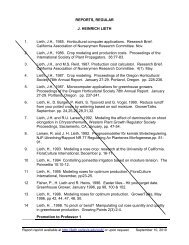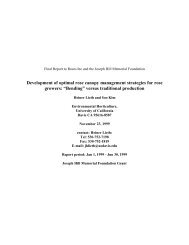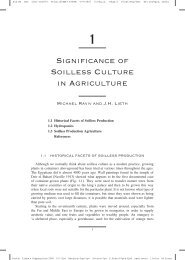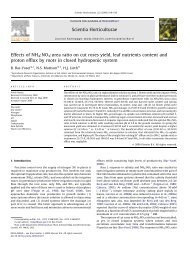Effects of Temperature on Leaf Area and Flower Size in Rose
Effects of Temperature on Leaf Area and Flower Size in Rose
Effects of Temperature on Leaf Area and Flower Size in Rose
You also want an ePaper? Increase the reach of your titles
YUMPU automatically turns print PDFs into web optimized ePapers that Google loves.
EFFECTS OF TEMPERATURE ON LEAF AREA AND FLOWER SIZE IN ROSE<br />
Hak Ki Sh<strong>in</strong><br />
Nati<strong>on</strong>al Horticultural Research Institute<br />
Suw<strong>on</strong> 440-310<br />
Republic <str<strong>on</strong>g>of</str<strong>on</strong>g> Korea<br />
J. He<strong>in</strong>rich Lieth <strong>and</strong> Soo-Hyung Kim<br />
Department <str<strong>on</strong>g>of</str<strong>on</strong>g> Envir<strong>on</strong>mental Horticulture<br />
University <str<strong>on</strong>g>of</str<strong>on</strong>g> California<br />
Davis, CA 95616-8587 USA<br />
Abstract<br />
The resp<strong>on</strong>se <str<strong>on</strong>g>of</str<strong>on</strong>g> ‘Kard<strong>in</strong>al’ rose plants to temperature was measured to develop a model for<br />
predict<strong>in</strong>g rose flower size for a range <str<strong>on</strong>g>of</str<strong>on</strong>g> greenhouse c<strong>on</strong>diti<strong>on</strong>s. The number <str<strong>on</strong>g>of</str<strong>on</strong>g> days from<br />
bud break (BB) to flower<strong>in</strong>g <strong>in</strong>creased from 21.6 to 63.0 days as temperature decreased<br />
from 30 to 15°C. The number <str<strong>on</strong>g>of</str<strong>on</strong>g> days to flower was primarily <strong>in</strong>fluenced by the temperature<br />
after the visible bud (VB). This suggests that the temperature before VB may not<br />
significantly affect the rate <str<strong>on</strong>g>of</str<strong>on</strong>g> flower development. <strong>Leaf</strong> area, stem length <strong>and</strong> stem<br />
diameter generally <strong>in</strong>creased with decreas<strong>in</strong>g temperature, but the best quality <str<strong>on</strong>g>of</str<strong>on</strong>g> stems was<br />
observed at 18°C. <strong>Flower</strong> dry weight, however, <strong>in</strong>creased from 0.7 to 3.0 g as temperature<br />
decreased from 30 to 15°C. When plants were moved to lower temperature at VB stage,<br />
flower dry weight <strong>in</strong>creased. <str<strong>on</strong>g>Temperature</str<strong>on</strong>g> has it’s most pr<strong>on</strong>ounce <strong>in</strong>fluence <strong>on</strong> flower<br />
development dur<strong>in</strong>g the period between VB <strong>and</strong> flower<strong>in</strong>g so that dur<strong>in</strong>g commercial<br />
greenhouse rose producti<strong>on</strong> any reducti<strong>on</strong> <strong>in</strong> temperature dur<strong>in</strong>g that period can result <strong>in</strong><br />
<strong>in</strong>creas<strong>in</strong>g the size <str<strong>on</strong>g>of</str<strong>on</strong>g> rose flower buds.<br />
1. Introducti<strong>on</strong><br />
<strong>Flower</strong> size <strong>and</strong> stem length are two important factors that dictate the value <str<strong>on</strong>g>of</str<strong>on</strong>g><br />
cut-flower roses. Optimizati<strong>on</strong> <str<strong>on</strong>g>of</str<strong>on</strong>g> rose cut-flower producti<strong>on</strong> requires the ability to predict<br />
the resp<strong>on</strong>se <str<strong>on</strong>g>of</str<strong>on</strong>g> plants to various envir<strong>on</strong>mental c<strong>on</strong>diti<strong>on</strong>s, particularly air temperature.<br />
Crop simulati<strong>on</strong> models can be used to quantify crop growth by simulat<strong>in</strong>g the effect <str<strong>on</strong>g>of</str<strong>on</strong>g><br />
temperature at various regimes (Lieth <strong>and</strong> Pasian, 1991).<br />
<str<strong>on</strong>g>Temperature</str<strong>on</strong>g> <strong>and</strong> light have been found to be the primary factors <str<strong>on</strong>g>of</str<strong>on</strong>g> rose crop growth<br />
<strong>and</strong> development. Light <strong>in</strong>tensity affects ma<strong>in</strong>ly the photosynthetic rate (Pasian <strong>and</strong> Lieth,<br />
1989), while temperature affects both photosynthesis <str<strong>on</strong>g>of</str<strong>on</strong>g> leaves <strong>and</strong> development <str<strong>on</strong>g>of</str<strong>on</strong>g> shoots<br />
(Lieth <strong>and</strong> Pasian, 1990; Moe, 1972; Ziesl<strong>in</strong> et al., 1987). Moe <strong>and</strong> Krist<str<strong>on</strong>g>of</str<strong>on</strong>g>fersen (1969)<br />
found that at high temperature the number <str<strong>on</strong>g>of</str<strong>on</strong>g> days from cut-back to flower<strong>in</strong>g was shorter<br />
<strong>and</strong> smaller flowers were observed as a result <str<strong>on</strong>g>of</str<strong>on</strong>g> fewer <strong>and</strong> smaller petals. Mor <strong>and</strong> Halevy<br />
(1979) found that at the early stage <str<strong>on</strong>g>of</str<strong>on</strong>g> shoot development young leaves were str<strong>on</strong>g s<strong>in</strong>ks<br />
<strong>and</strong> reta<strong>in</strong>ed most <str<strong>on</strong>g>of</str<strong>on</strong>g> their own photosynthates, then became source leaves after the visible<br />
bud stage. Jiao <strong>and</strong> Grodz<strong>in</strong>ski (1998) reported that carbohydrate export rate <str<strong>on</strong>g>of</str<strong>on</strong>g> exp<strong>and</strong>ed<br />
leaves <strong>on</strong> the flower<strong>in</strong>g shoot was reduced by 80% under high temperature (40°C) <strong>and</strong><br />
suggested that temperature <strong>in</strong>fluences export <strong>and</strong> partiti<strong>on</strong><strong>in</strong>g <str<strong>on</strong>g>of</str<strong>on</strong>g> assimilates. The export<br />
rate <str<strong>on</strong>g>of</str<strong>on</strong>g> carbohydrate depends <strong>on</strong> the maturati<strong>on</strong> <str<strong>on</strong>g>of</str<strong>on</strong>g> leaf <strong>and</strong> shoot (Jiao et al., 1989). Khayat<br />
<strong>and</strong> Ziesl<strong>in</strong> (1986) reported that low temperature promoted the translocati<strong>on</strong> <str<strong>on</strong>g>of</str<strong>on</strong>g> labeled<br />
carb<strong>on</strong> toward the basal plant parts. Low temperature affects dark respirati<strong>on</strong> so that<br />
carbohydrate c<strong>on</strong>sumpti<strong>on</strong> is <strong>in</strong>hibited (Khayat et al., 1988). Although photosynthesis <strong>and</strong><br />
respirati<strong>on</strong> rates are useful parameters <strong>in</strong> crop simulati<strong>on</strong> models, <strong>in</strong>formati<strong>on</strong> <str<strong>on</strong>g>of</str<strong>on</strong>g> gas<br />
exchange by itself reveals little about development <str<strong>on</strong>g>of</str<strong>on</strong>g> flower bud <strong>and</strong> quality <str<strong>on</strong>g>of</str<strong>on</strong>g> flowers.<br />
The aim <str<strong>on</strong>g>of</str<strong>on</strong>g> this study was to <strong>in</strong>vestigate the development <str<strong>on</strong>g>of</str<strong>on</strong>g> leaf area <strong>and</strong> flowers <str<strong>on</strong>g>of</str<strong>on</strong>g> rose<br />
shoots <strong>in</strong> resp<strong>on</strong>se to various temperature c<strong>on</strong>diti<strong>on</strong>s, especially when plants are subjected<br />
to a shift <strong>in</strong> temperature dur<strong>in</strong>g flower development.<br />
Proc. III IS <strong>Rose</strong> Research<br />
Eds. N. Ziesl<strong>in</strong> & H. Agbaria<br />
Acta Hort. 547, ISHS 2001<br />
185
2. Materials <strong>and</strong> methods<br />
Two-year-old ‘Kard<strong>in</strong>al’ plants were grown <strong>in</strong> <strong>on</strong>e-gall<strong>on</strong> pots <strong>in</strong> UC mix<br />
c<strong>on</strong>ta<strong>in</strong><strong>in</strong>g s<strong>and</strong>, redwood sawdust <strong>and</strong> peat moss (1:1:1, v/v). The experiment was carried<br />
out at the Department <str<strong>on</strong>g>of</str<strong>on</strong>g> Envir<strong>on</strong>mental Horticulture at the University <str<strong>on</strong>g>of</str<strong>on</strong>g> California <strong>in</strong><br />
Davis CA, from 20 June 1999 to 7 January 2000. Six c<strong>on</strong>stant <strong>and</strong> six vary<strong>in</strong>g temperature<br />
regimes rang<strong>in</strong>g from 15°C to 30°C were used as treatments (Table 1). The temperature<br />
setpo<strong>in</strong>ts represent treatments; plants shifted from <strong>on</strong>e temperature to another are <strong>in</strong>dicated<br />
us<strong>in</strong>g two temperatures separated by a dash (e.g. 18-30). Plants were grown <strong>in</strong> the<br />
greenhouse then moved to the growth chamber for the experiment after a cut-back. The rose<br />
shoot developmental events were named as described <strong>in</strong> Pasian <strong>and</strong> Lieth (1994). For<br />
vary<strong>in</strong>g temperature treatments, plants were moved from the first temperature to the sec<strong>on</strong>d<br />
temperature at visible bud stage (VB). The plants were kept <strong>in</strong> the growth chamber until the<br />
flower becomes harvestable (HV).<br />
The experiment was carried out over three periods, each with different temperature<br />
treatments: (1) from June to August 1999 for the temperatures <str<strong>on</strong>g>of</str<strong>on</strong>g> 18 <strong>and</strong> 30°C, (2) early<br />
September to late October 1999 for 21 <strong>and</strong> 27°C <strong>and</strong> (3) from late November 1999 to early<br />
February 2000 for 15 <strong>and</strong> 24°C. Plants were moved <strong>in</strong>to the growth chamber for<br />
acclimati<strong>on</strong> about a week prior to bud break (BB). The stage where a grow<strong>in</strong>g bud has<br />
reached a length <str<strong>on</strong>g>of</str<strong>on</strong>g> 10 mm was deemed as bud break (BB). Irrigati<strong>on</strong> was d<strong>on</strong>e daily with<br />
half-strength Hoagl<strong>and</strong>'s soluti<strong>on</strong>. For 30°C, plants were irrigated twice per day.<br />
<strong>Flower</strong><strong>in</strong>g shoots were harvested when the outer petals were erect (HV). Stem<br />
length was measured from the base <str<strong>on</strong>g>of</str<strong>on</strong>g> the shoot to the base <str<strong>on</strong>g>of</str<strong>on</strong>g> the flower. <strong>Leaf</strong> area was<br />
estimated n<strong>on</strong>destructively from leaf length us<strong>in</strong>g an empirical relati<strong>on</strong> (data not shown).<br />
<strong>Leaf</strong> length was determ<strong>in</strong>ed from the end <str<strong>on</strong>g>of</str<strong>on</strong>g> the petiole to the tip <str<strong>on</strong>g>of</str<strong>on</strong>g> the term<strong>in</strong>al leaflet. A<br />
high-pressure sodium lamp was used as light source, with a 15-hour photoperiod.<br />
Photosynthetic active radiati<strong>on</strong> (PAR) was approximately 300 – 500 µmol m -2 s -1 . Plant<br />
locati<strong>on</strong> <strong>and</strong> distance from the lamp was adjusted every 4-5 days to ma<strong>in</strong>ta<strong>in</strong> the same light<br />
level <strong>and</strong> temperature at the shoots. There was a temperature difference <str<strong>on</strong>g>of</str<strong>on</strong>g> ±2-3°C between<br />
day <strong>and</strong> night time <strong>in</strong> 15°C treatment due to the heat emitted from the lamp. The<br />
developmental stage <str<strong>on</strong>g>of</str<strong>on</strong>g> the shoots was checked daily. After VB, bud diameter was<br />
measured every day. Dur<strong>in</strong>g the grow<strong>in</strong>g period, flower bud dry weight was estimated<br />
n<strong>on</strong>destructively us<strong>in</strong>g an empirical relati<strong>on</strong> with bud diameter (R 2 =0.961; data not shown).<br />
<str<strong>on</strong>g>Temperature</str<strong>on</strong>g> data were collected us<strong>in</strong>g electr<strong>on</strong>ic dataloggers. Dur<strong>in</strong>g the experiment, daily<br />
mean air temperature was uniform (Table 1).<br />
At harvest the leaf area, flower dry weight <strong>and</strong> diameter at the middle <str<strong>on</strong>g>of</str<strong>on</strong>g> the stem<br />
were measured; flower dry weight was measured after dry<strong>in</strong>g for 3 days at 80°C.<br />
3. Results<br />
The length <str<strong>on</strong>g>of</str<strong>on</strong>g> the shoot development, measured as days, generally decreased as<br />
mean air temperature <strong>in</strong>creased (Table 2). The number <str<strong>on</strong>g>of</str<strong>on</strong>g> days from bud break <strong>in</strong> 15°C was<br />
63, about 3 times <str<strong>on</strong>g>of</str<strong>on</strong>g> that <strong>in</strong> 30°C.<br />
In the vary<strong>in</strong>g temperature treatments, the number <str<strong>on</strong>g>of</str<strong>on</strong>g> days from VB to HV was<br />
almost identical to the treatment that ma<strong>in</strong>ta<strong>in</strong>ed the same temperature c<strong>on</strong>stantly from BB<br />
to HV as the sec<strong>on</strong>d temperature <str<strong>on</strong>g>of</str<strong>on</strong>g> the vary<strong>in</strong>g temperature treatment. For example, when<br />
the plants were moved from 21 to 27°C at visible bud stage, the number <str<strong>on</strong>g>of</str<strong>on</strong>g> days from VB to<br />
harvest was 9.6 days, <strong>and</strong> it was 9.8 days for c<strong>on</strong>stant 27°C. However, when plants were<br />
moved from high to low temperature (i.e., 24 to 15°C, 30 to 18°C), the number <str<strong>on</strong>g>of</str<strong>on</strong>g> days to<br />
flower decreased by <strong>on</strong>e or two days compared with the c<strong>on</strong>stant temperature <str<strong>on</strong>g>of</str<strong>on</strong>g> the sec<strong>on</strong>d<br />
period. The number <str<strong>on</strong>g>of</str<strong>on</strong>g> leaves per shoot was around 14, not affected by temperature (Table<br />
3). Stem length, diameter <strong>and</strong> leaf area decreased with <strong>in</strong>creas<strong>in</strong>g temperature (Table 3).<br />
The best quality <str<strong>on</strong>g>of</str<strong>on</strong>g> the shoot, however, was observed at 18°C.<br />
Maximum mean leaf area was found at 18°C. Variati<strong>on</strong> with<strong>in</strong> treatments was high<br />
for leaf area. In the vary<strong>in</strong>g temperatures, leaf area was <strong>in</strong>creased when moved to lower<br />
186<br />
Proc. III IS <strong>Rose</strong> Research<br />
Eds. N. Ziesl<strong>in</strong> & H. Agbaria<br />
Acta Hort. 547, ISHS 2001
temperature <strong>and</strong> de-creased when moved to higher temperature compared with c<strong>on</strong>stant<br />
temperature.<br />
<strong>Flower</strong> fresh <strong>and</strong> dry weights decreased with <strong>in</strong>creas<strong>in</strong>g temperature (Fig 1). Mean<br />
flower dry weight at 15°C was 3 g while at temperatures above 24°C it was less than 2 g.<br />
<strong>Flower</strong> growth rate, <strong>on</strong> dry matter basis, was highest between 18° <strong>and</strong> 21°C (Fig 2).<br />
4. Discussi<strong>on</strong><br />
The number <str<strong>on</strong>g>of</str<strong>on</strong>g> days from bud break <strong>in</strong> 15°C was about 3 times <str<strong>on</strong>g>of</str<strong>on</strong>g> that <strong>in</strong> 30°C. The<br />
similar results have been reported by Moe <strong>and</strong> Krist<str<strong>on</strong>g>of</str<strong>on</strong>g>fersen (1969) that the number <str<strong>on</strong>g>of</str<strong>on</strong>g> days<br />
from cut-back to flower <strong>in</strong>creased with decreas<strong>in</strong>g temperature.<br />
We found that the number <str<strong>on</strong>g>of</str<strong>on</strong>g> days from VB to HV <strong>in</strong> vary<strong>in</strong>g temperature were<br />
almost the same as the c<strong>on</strong>stant temperature treatment <str<strong>on</strong>g>of</str<strong>on</strong>g> the sec<strong>on</strong>d period. It appears that<br />
the number <str<strong>on</strong>g>of</str<strong>on</strong>g> days to flower from VB depends primarily <strong>on</strong> the temperature dur<strong>in</strong>g the later<br />
period rather than the period prior to VB.<br />
The number <str<strong>on</strong>g>of</str<strong>on</strong>g> leaves per flower<strong>in</strong>g stem was not affected by temperature (Table 3).<br />
Marcelis-van Acker (1994, 1995) reported that the number <str<strong>on</strong>g>of</str<strong>on</strong>g> leaves is determ<strong>in</strong>ed dur<strong>in</strong>g<br />
the axillary bud formati<strong>on</strong> <strong>and</strong> most <str<strong>on</strong>g>of</str<strong>on</strong>g> leaves differentiated dur<strong>in</strong>g the development <str<strong>on</strong>g>of</str<strong>on</strong>g> the<br />
parent shoot. In our study, the plants were grown under the same envir<strong>on</strong>mental c<strong>on</strong>diti<strong>on</strong><br />
<strong>in</strong> the greenhouse until a week prior to BB where they were moved to the growth chamber.<br />
As a result, the plants probably formed the same number <str<strong>on</strong>g>of</str<strong>on</strong>g> leaves before receiv<strong>in</strong>g the<br />
treatments.<br />
The best quality <str<strong>on</strong>g>of</str<strong>on</strong>g> shoots, <strong>in</strong> terms <str<strong>on</strong>g>of</str<strong>on</strong>g> stem length, diameter <strong>and</strong> leaf area, was<br />
obta<strong>in</strong>ed at 18°C (Table 3). Moe <strong>and</strong> Krist<str<strong>on</strong>g>of</str<strong>on</strong>g>fersen (1969) also noted that the best quality<br />
occurred at 18°C.<br />
There was large variati<strong>on</strong> <strong>in</strong> leaf area per stem even at the same temperature. These<br />
variati<strong>on</strong>s are probably caused by the c<strong>on</strong>diti<strong>on</strong>s <str<strong>on</strong>g>of</str<strong>on</strong>g> mother plant or shoot. Marcelis-van<br />
Acker (1994) reported that stem diameter was closely related to pith diameter that had<br />
<strong>in</strong>fluences <strong>on</strong> the accumulati<strong>on</strong> <strong>and</strong> distributi<strong>on</strong> <str<strong>on</strong>g>of</str<strong>on</strong>g> stored substances like starch <strong>and</strong> sugars,<br />
<strong>and</strong> the potential diameter <str<strong>on</strong>g>of</str<strong>on</strong>g> pith was determ<strong>in</strong>ed by the number <str<strong>on</strong>g>of</str<strong>on</strong>g> cells produced at the<br />
axillary bud stage.<br />
The relati<strong>on</strong>ship <str<strong>on</strong>g>of</str<strong>on</strong>g> both flower fresh <strong>and</strong> dry weight with temperature (Table 3)<br />
agreed with the results reported by Fisher (1999). Increases <strong>in</strong> the dry weight at lower<br />
temperature may be due to the <strong>in</strong>creased number <str<strong>on</strong>g>of</str<strong>on</strong>g> days to flower <strong>and</strong> decreased dark<br />
respirati<strong>on</strong> rate <strong>in</strong> resp<strong>on</strong>se to low temperature (Khayat et al, 1988). The number <str<strong>on</strong>g>of</str<strong>on</strong>g> days<br />
from VB to HV at 15°C was 3.4 times l<strong>on</strong>ger than 30°C. Dry weight at 15°C was more than<br />
4 times higher than at 30°C. Increased carbohydrate c<strong>on</strong>sumpti<strong>on</strong> by the respirati<strong>on</strong> through<br />
various parts (i.e., roots, flower buds <strong>and</strong> leaves) may be resp<strong>on</strong>sible for the decrease <strong>in</strong><br />
flower dry weight at higher temperatures. High evapotranspirati<strong>on</strong> rate at high temperature<br />
could be another factor affect<strong>in</strong>g the decrease <strong>in</strong> flower dry weight. Jiao <strong>and</strong> Grodz<strong>in</strong>ski<br />
(1998) reported that the photosynthesis rate <strong>and</strong> c<strong>on</strong>current carb<strong>on</strong> export from leaf at 15°C<br />
<strong>and</strong> 40°C was significantly lower than at 25°C. It was, however, not clear whether the<br />
export was toward flower bud or the other plant part.<br />
Moe <strong>and</strong> Krist<str<strong>on</strong>g>of</str<strong>on</strong>g>fersen (1969) reported that the decrease <str<strong>on</strong>g>of</str<strong>on</strong>g> flower dry weight at high<br />
temperature was related to fewer <strong>and</strong> smaller petals. Byrne et al. (1978) also reported the<br />
great <strong>in</strong>crease <strong>in</strong> the number <str<strong>on</strong>g>of</str<strong>on</strong>g> petals at low temperature. We observed that the number <str<strong>on</strong>g>of</str<strong>on</strong>g><br />
petals at 30°C was approximately 14-15. Mov<strong>in</strong>g plants from 30°C to 18°C at VB resulted<br />
<strong>in</strong> an <strong>in</strong>crease <str<strong>on</strong>g>of</str<strong>on</strong>g> 120% <strong>in</strong> dry weight (1.51g), compared with plants that stayed at c<strong>on</strong>stant<br />
30°C (0.69g). The number <str<strong>on</strong>g>of</str<strong>on</strong>g> petals would be similar for both cases s<strong>in</strong>ce it had been<br />
determ<strong>in</strong>ed dur<strong>in</strong>g the early stage <str<strong>on</strong>g>of</str<strong>on</strong>g> shoot development (Horridge <strong>and</strong> Cockshull, 1974;<br />
Moe <strong>and</strong> Krist<str<strong>on</strong>g>of</str<strong>on</strong>g>fersen, 1969). Therefore, it can be c<strong>on</strong>sidered that the <strong>in</strong>crease <strong>in</strong> bud<br />
weight <strong>in</strong> vary<strong>in</strong>g temperature resulted from the <strong>in</strong>creased petal size. On the other h<strong>and</strong>,<br />
when this dry weight was compared with that at c<strong>on</strong>stant 18°C (2.27g), the difference seems<br />
to come from the difference <strong>in</strong> number <str<strong>on</strong>g>of</str<strong>on</strong>g> petals. Jiao <strong>and</strong> Grodz<strong>in</strong>ski (1998) reported that<br />
the higher export rate <str<strong>on</strong>g>of</str<strong>on</strong>g> assimilates would be due to the development <str<strong>on</strong>g>of</str<strong>on</strong>g> leaf lam<strong>in</strong>ar tissues<br />
Proc. III IS <strong>Rose</strong> Research<br />
Eds. N. Ziesl<strong>in</strong> & H. Agbaria<br />
Acta Hort. 547, ISHS 2001<br />
187
<strong>and</strong> the <strong>in</strong>creased s<strong>in</strong>k strength as a result <str<strong>on</strong>g>of</str<strong>on</strong>g> the development <str<strong>on</strong>g>of</str<strong>on</strong>g> flower bud. Perhaps the<br />
<strong>in</strong>crease <strong>in</strong> dry weight at low temperature is related to <strong>in</strong>creased s<strong>in</strong>k strength <strong>in</strong> resp<strong>on</strong>se to<br />
the large number petals, <strong>and</strong> due to the <strong>in</strong>creased leaf area <strong>and</strong> greater number <str<strong>on</strong>g>of</str<strong>on</strong>g> days to<br />
flower.<br />
This work is the start<strong>in</strong>g po<strong>in</strong>t for the development <str<strong>on</strong>g>of</str<strong>on</strong>g> a model relat<strong>in</strong>g the dynamic<br />
changes <strong>in</strong> flower bud expansi<strong>on</strong> rate <strong>in</strong> relati<strong>on</strong> to daily variati<strong>on</strong>s <strong>in</strong> temperature. Such a<br />
model can be quite useful to growers to assist with m<strong>in</strong>imiz<strong>in</strong>g energy usage for greenhouse<br />
cool<strong>in</strong>g when try<strong>in</strong>g to <strong>in</strong>crease flower bud size at times <str<strong>on</strong>g>of</str<strong>on</strong>g> hot weather when the reducti<strong>on</strong><br />
<strong>in</strong> flower size can render them unsalable. Dur<strong>in</strong>g hot humid weather, greenhouse growers<br />
are frequently unable to keep temperatures below 25°C <strong>and</strong> thus loose flower head size as<br />
shown <strong>in</strong> this study. Recovery from this appears to be feasible but requires substantial<br />
cool<strong>in</strong>g. Thus growers will need to cool to an extent that rescues the crop while m<strong>in</strong>imiz<strong>in</strong>g<br />
the result<strong>in</strong>g energy costs.<br />
References<br />
Byrne T.G., R.P. Doss, <strong>and</strong> A.T.Y. Tse. 1978. <strong>Flower</strong> <strong>and</strong> shoot development <strong>in</strong> the<br />
greenhouse roses, ‘Cara Mia’ <strong>and</strong> ‘Town Crier’, under several temperature –<br />
photoperiodic regimes. J. Amer. Soc. Hort. Sci. 103(4):500-502.<br />
Fisher P. R. 1999. Optimiz<strong>in</strong>g greenhouse temperature for rose flower head size <strong>and</strong><br />
productivity(research report). <strong>Rose</strong> Inc. Bullet<strong>in</strong>. March 1999:57-63.<br />
Horridge J.S. <strong>and</strong> K.E. Cockshull. 1974. <strong>Flower</strong> <strong>in</strong>itiati<strong>on</strong> <strong>and</strong> development <strong>in</strong> the<br />
glasshouse rose. Scientia Horticulture. 2:273-284.<br />
Jiao J. <strong>and</strong> B. Grodz<strong>in</strong>ski. 1998. Envir<strong>on</strong>mental <strong>in</strong>fluences <strong>on</strong> photosynthesis <strong>and</strong> carb<strong>on</strong><br />
export <strong>in</strong> greenhouse roses dur<strong>in</strong>g development <str<strong>on</strong>g>of</str<strong>on</strong>g> the flower<strong>in</strong>g shoot. J. Amer. Soc.<br />
Hort. Sci. 123(6):1081-1088.<br />
Jiao J., M. Gilmour, M, J. Tsujita <strong>and</strong> B. Grodz<strong>in</strong>ski. 1989. Photosynthesis <strong>and</strong> carb<strong>on</strong><br />
partiti<strong>on</strong><strong>in</strong>g <strong>in</strong> Samantha roses. Can. J. Plant Sci. 69:577-584.<br />
Khayat E. <strong>and</strong> N. Ziesl<strong>in</strong>. 1986. Effect <str<strong>on</strong>g>of</str<strong>on</strong>g> different night temperature regimes <strong>on</strong> the<br />
assimilati<strong>on</strong>, transport <strong>and</strong> metabolism <str<strong>on</strong>g>of</str<strong>on</strong>g> carb<strong>on</strong> <strong>in</strong> rose plants. Physiol. Plant.<br />
67:608-613.<br />
Khayat E., N. Ziesl<strong>in</strong>, L. Mortensen, <strong>and</strong> R. Moe. 1988. Effect <str<strong>on</strong>g>of</str<strong>on</strong>g> alternat<strong>in</strong>g temperature <strong>on</strong><br />
dark respirati<strong>on</strong> <strong>and</strong> 14 C-export <strong>in</strong> rose plants. J. Plant Physiol. 133:199-202.<br />
Lieth J. H. <strong>and</strong> C. C. Pasian. 1990. A model for net photosynthesis <str<strong>on</strong>g>of</str<strong>on</strong>g> rose leaves as a<br />
functi<strong>on</strong> <str<strong>on</strong>g>of</str<strong>on</strong>g> photosynthetically active radiati<strong>on</strong>, leaf temperature, <strong>and</strong> leaf age. J. Amer.<br />
Soc. Hort. Sci. 115(3):486-491.<br />
Lieth J. H. <strong>and</strong> C. C. Pasian. 1991. A simulati<strong>on</strong> model for the growth <strong>and</strong> development <str<strong>on</strong>g>of</str<strong>on</strong>g><br />
flower<strong>in</strong>g rose shoot. Scientia Horticulture. 46:109-128.<br />
Marcelis-van Acker C.A.M. 1994. Ontogeny buds <strong>and</strong> shoots <strong>in</strong> roses: leaf <strong>in</strong>itiati<strong>on</strong> <strong>and</strong><br />
pith development. Scientia Horticulture. 57:111-122.<br />
Marcelis-van Acker C.A.M. 1995. Effect <str<strong>on</strong>g>of</str<strong>on</strong>g> temperature <strong>on</strong> development <strong>and</strong> growth <strong>and</strong><br />
potential <str<strong>on</strong>g>of</str<strong>on</strong>g> axillary buds <strong>in</strong> roses. Scientia Horticulture. 63:241-250.<br />
Moe R. 1972. Effect <str<strong>on</strong>g>of</str<strong>on</strong>g> daylength, light <strong>in</strong>tensity <strong>and</strong> temperature <strong>on</strong> growth <strong>and</strong> flower<strong>in</strong>g<br />
<strong>in</strong> roses. J. Amer. Soc. Hort. Sci. 97(6):796-800.<br />
Moe R. <strong>and</strong> T. Krist<str<strong>on</strong>g>of</str<strong>on</strong>g>fersen. 1969. The effect <str<strong>on</strong>g>of</str<strong>on</strong>g> temperature <strong>and</strong> light <strong>on</strong> growth <strong>and</strong><br />
flower<strong>in</strong>g <str<strong>on</strong>g>of</str<strong>on</strong>g> Rosa ‘Baccara’ <strong>in</strong> greenhouse. Acta Hort., 14:157-166.<br />
Mor Y. <strong>and</strong> A. H. Halevy. 1979. Translocati<strong>on</strong> <str<strong>on</strong>g>of</str<strong>on</strong>g> 14 C-assimilates <strong>in</strong> roses. I. The effect <str<strong>on</strong>g>of</str<strong>on</strong>g><br />
the age <str<strong>on</strong>g>of</str<strong>on</strong>g> the shoot <strong>and</strong> the locati<strong>on</strong> <str<strong>on</strong>g>of</str<strong>on</strong>g> the source leaf. Physiol. Plant. 45:177-182.<br />
Pasian C. C. <strong>and</strong> J. H. Lieth. 1989. Analysis <str<strong>on</strong>g>of</str<strong>on</strong>g> the resp<strong>on</strong>se <str<strong>on</strong>g>of</str<strong>on</strong>g> net photosynthesis <str<strong>on</strong>g>of</str<strong>on</strong>g> rose<br />
leaves <str<strong>on</strong>g>of</str<strong>on</strong>g> vary<strong>in</strong>g ages to photosynthetically active radiati<strong>on</strong> <strong>and</strong> temperature. J. Amer.<br />
Soc. Hort. Sci. 114(4):581-586.<br />
Ziesl<strong>in</strong> N., E. Khayat, <strong>and</strong> Y. Mor. 1987. The resp<strong>on</strong>se <str<strong>on</strong>g>of</str<strong>on</strong>g> rose plants to different night<br />
temperature regimes. J. Amer. Soc. Hort. Sci. 112(1):86-89.<br />
188<br />
Proc. III IS <strong>Rose</strong> Research<br />
Eds. N. Ziesl<strong>in</strong> & H. Agbaria<br />
Acta Hort. 547, ISHS 2001
Tables<br />
Table 1. <str<strong>on</strong>g>Temperature</str<strong>on</strong>g>s dur<strong>in</strong>g experiment.<br />
Treatment<br />
Mean <str<strong>on</strong>g>Temperature</str<strong>on</strong>g><br />
BB - VB VB - HV Total<br />
15 15.4 ± 0.22 * 15.7 ± 0.14 15.5 + 0.08<br />
15 - 24 15.0 ± 0.08 25.4 ± 0.10 17.5 ± 0.24<br />
18 17.6 ± 0.17 17.7 ± 0.21 17.7 ± 0.05<br />
18 - 30 17.7 ± 0.27 30.0 ± 0.66 21.3 ± 0.47<br />
21 21.4 ± 0.13 21.1 ± 0.14 21.3 ± 0.04<br />
21 - 27 21.5 ± 0.13 27.5 ± 0.38 23.9 ± 0.27<br />
24 24.4 ± 0.09 24.9 ± 0.22 24.6 ± 0.05<br />
24 - 15 24.2 ± 0.21 16.0 ± 0.16 19.2 ± 0.33<br />
27 28.0 ± 0.26 27.8 ± 0.43 27.8 ± 0.11<br />
27 - 21 28.0 ± 0.44 21.0 ± 0.05 24.1± 0.51<br />
30 30.6 ± 0.23 30.2 ± 0.26 30.4 ± 0.17<br />
30 - 18 30.5 ± 0.33 18.2 ± 0.43 23.6 ± 0.55<br />
* Mean ± st<strong>and</strong>ard deviati<strong>on</strong><br />
Table 2. Effect <str<strong>on</strong>g>of</str<strong>on</strong>g> temperature <strong>on</strong> grow<strong>in</strong>g period <str<strong>on</strong>g>of</str<strong>on</strong>g> roses<br />
Treatment<br />
Days to<br />
BB - FLU BB - VB BB - LLU VB - HV Total<br />
15 11.4 a * 33.8 a 41.1 a 29.2 a 63.0 a<br />
15 - 24 10.4 a 28.3 b 32.0 b 12.3 f 40.7 c<br />
18 8.3 b 22.0 c 28.1 c 18.8 c 40.8 c<br />
18 - 30 8.3 b 22.9 c 27.5 c 9.6 g 32.4 d<br />
21 6.6 c 16.5 d 20.3 d 13.8 e 30.3 de<br />
21 - 27 6.4 cd 16.3 d 20.3 d 9.6 g 25.9 f<br />
24 6.0 cd 15.7 d 19.2 de 12.6 ef 28.3 e<br />
24 - 15 6.2 cd 16.2 d 21.0 d 27.0 b 43.2 b<br />
27 5.6 cd 13.0 e 16.1 f 9.8 g 22.8 gh<br />
27 - 21 5.7 cd 12.2 e 16.1 f 12.7 ef 24.8 fg<br />
30 5.4 d 12.9 e 17.3 ef 8.7 g 21.6 h<br />
30 - 18 5.4 d 12.8 e 18.3 e 17.5 d 30.3 de<br />
* DMRT level .05 <strong>in</strong> column<br />
Proc. III IS <strong>Rose</strong> Research<br />
Eds. N. Ziesl<strong>in</strong> & H. Agbaria<br />
Acta Hort. 547, ISHS 2001<br />
189
Table 3. Effect <str<strong>on</strong>g>of</str<strong>on</strong>g> temperature <strong>on</strong> growth <strong>and</strong> flower<strong>in</strong>g <str<strong>on</strong>g>of</str<strong>on</strong>g> roses.<br />
Treat No. leaves Stem length Stem diameter <strong>Leaf</strong> area <strong>Flower</strong> F.W <strong>Flower</strong> D.W<br />
C cm cm cm 2 g g<br />
15 15.4 ab * 61.6 b 7.0 b 664 bc 17.3 a 3.04 a<br />
15 - 24 15.7 a 60.0 b 6.3 bc 583 cd 10.2 c 1.74 d<br />
18 15.1 ab 79.1 a 8.1 a 890 a 13.1 b 2.27 c<br />
18 - 30 13.9 abc 57.9 bc 7.1 b 756 b 5.48 h 1.06 fg<br />
21 14.1 abc 62.0 b 7.0 b 647 bc 8.6 d 1.65 d<br />
21 - 27 14.1 abc 50.7 c 6.3 bc 490 dc 4.4 hi 0.90 gh<br />
24 14.6 ab 55.2 bc 6.3 bc 499de 7.1 ef 1.31 ef<br />
24 - 15 15.3 ab 57.3 bc 6.8 b 538 cde 12.9 b 2.54 b<br />
27 14.4 abc 40.8 d 6.5 bc 472 dc 4.2 hi 0.89 gh<br />
27 - 21 12.7 c 41.8 d 7.1 b 438 ef 6.2 fg 1.23 f<br />
30 13.7 bc 29.5 e 5.7 c 327 f 3.1 i 0.69 h<br />
30 - 18 15.4 ab 42.1 d 6.3 bc 456 def 7.9 de 1.51de<br />
* DMRT level .05 <strong>in</strong> column.<br />
Figures<br />
Weight <str<strong>on</strong>g>of</str<strong>on</strong>g> flower bud (g)<br />
24<br />
20<br />
16<br />
12<br />
8<br />
4<br />
0<br />
4<br />
2<br />
Fresh Weight = 55 - 3.25 T + 0.051 T 2<br />
R 2 =0.89<br />
Dry Weight = 9.26 - 0.54 T + 0.0084 T 2<br />
R 2 =0.87<br />
0<br />
12 14 16 18 20 22 24 26 28 30 32<br />
<str<strong>on</strong>g>Temperature</str<strong>on</strong>g> (C)<br />
Fig 1. Effect <str<strong>on</strong>g>of</str<strong>on</strong>g> temperature <strong>on</strong> flower bud fresh <strong>and</strong> dry weight.<br />
190<br />
Proc. III IS <strong>Rose</strong> Research<br />
Eds. N. Ziesl<strong>in</strong> & H. Agbaria<br />
Acta Hort. 547, ISHS 2001
<strong>Flower</strong> weight Accumulati<strong>on</strong> Rate (g/day)<br />
1.2<br />
1.0<br />
0.8<br />
0.6<br />
0.4<br />
0.2<br />
0.0<br />
0.20<br />
0.16<br />
0.12<br />
0.08<br />
0.04<br />
Fresh weight FW = -0.053 + 0.076 T - 0.0021 T 2<br />
R 2 =0.49<br />
Dry weight DW = -0.0299 + 0.015 T - 0.00037 T 2<br />
R 2 =0.30<br />
12 14 16 18 20 22 24 26 28 30 32 34<br />
<str<strong>on</strong>g>Temperature</str<strong>on</strong>g> (C)<br />
Fig 2. Effect <str<strong>on</strong>g>of</str<strong>on</strong>g> temperature <strong>on</strong> growth rate <str<strong>on</strong>g>of</str<strong>on</strong>g> flower bud.<br />
Proc. III IS <strong>Rose</strong> Research<br />
Eds. N. Ziesl<strong>in</strong> & H. Agbaria<br />
Acta Hort. 547, ISHS 2001<br />
191








